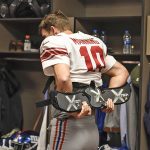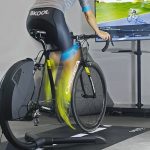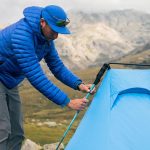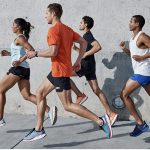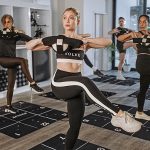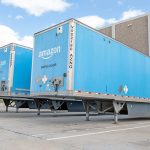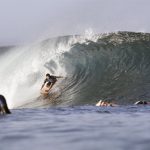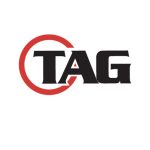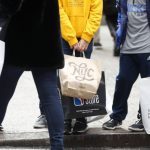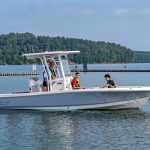Nike, Inc. surpassed analysts earnings expectations for the fiscal third quarter ended February 28 and posted solid double-digit revenue gains in Europe, Asia-Pacific, and the subsidiary business that includes Cole Haan, Nike Golf, Exeter Brands, Nike Bauer Hockey, and Converse, but weakness with some mall retailers helped stymie growth in the U.S. market for the period. Still, the company remains optimistic about the future and pointed to solid futures growth at the end of the quarter as a key indicator for a promising year ahead.
In a conference call with analysts and investors, company President & CEO Mark Parker said that runners using the new Nike+ product have logged more than 10 million miles in their shoes. He indicated that all Nike performance running product would be Nike+ enabled by the Holiday period. The Bowerman performance running shoes posted 11% growth in the third quarter. However, a decline in average selling prices in the U.S. market partially offset a mid-single-digit gain in unit sales for the quarter. The issue may well be due in large part to the launch a year ago of the new 360 range, which saw the company gobble up share in running, particularly in the over-$100 price range.
The year ahead will include a more refined approach to how Nike reaches the consumer. “Power continues to shift to consumers,” said Parker, and he sees opportunity here, saying that, “Connecting with consumers is something we do intuitively.” Part of this connection will undoubtedly be reflected in how the company implements and drives its expanded owned-retail strategy discussed at its investor day (SEW_0707). Over the next three years, the company anticipates opening approximately 100 mall-based Nike-only stores worldwide, half of which are expected in the U.S. The new retail initiative is planned to have “customer-focused formats.” By 2011, the company expects Nike direct-to-consumer sales, which include inline stores, factory outlets, and e-commerce, to increase to 15% of sales or $3.5 billion, up from the current 12%.
The other component of the mall strategy will include a more refined partnership strategy with key retailers, a program first hinted at by Foot Locker, Inc. at the Bank of America investor conference last week (SEW_0712). SEW expects that the strategy will be all about developing the best product mix and retail experience for retailers they wish to reach and then defining the retailers that best serve that consumer group. The strategy is also interwoven with the companys new structure to service the market through six core categories: running, basketball, soccer, women's fitness, men's training and sport culture. This may mean that some Foot Locker divisions would be designated as the primary destination for the urban consumer, while Journeys would be the key for the metro sport culture consumer, and Finish Line and Champs could be designated as the primary shopping destination for other categories.
Nike would develop a total sales strategy with the retailers in an effort to differentiate the shopping experience in the mall. Their owned-retail strategy would then round out how the brand shows up in the mall.
Sales at Nike owned-retail stores in the U.S. grew 9% for the quarter, with comp store sales at Niketown stores increasing 2% for the period.
For the third quarter, the Nike brand posted a 6.6% increase in footwear sales to $2.13 billion, or a 4% increase when measured in currency-neutral terms. Apparel sales were up 9.1% to $1.04 billion, reflecting a 5% gain in currency-neutral terms, while equipment sales jumped 12.9% to $230 million, or a 9% gain when accounting for the weaker U.S. Dollar.
Management said the 9% increase (+8% c-n) in order backlog at quarter-end was concentrated in the back-end of the futures window through July, driven by strong growth for the Fall season.
In the EMEA region, which includes Europe, the Middle East and Africa, the roughly nine points of the 14.8% increase in sales came from shifts in currency. The U.K. and France, two of the three largest markets in the region were still challenged, but management hinted that they may be turning the corner as some of the promotional activity starts to subside in the U.K.. All other countries in the region posted currency-neutral sales growth, the emerging markets group grew over 30%, thanks to “strong results” in Russia, South Africa, and Turkey. Management said they saw “good growth” coming out of Italy, Spain and Germany as well. Foot Locker Europe is apparently a key to the growth strategies in the region going forward as is a shop-in-shop program set up with JJB Sports in the U.K. that they see growing from its current 15 door test to over 100 stores in the “next six to 12 months.” Nike has “made some significant progress” in the low-profile product, but has also seen the performance business pick up.
Currency-neutral footwear revenues were up 4% for the period on the strength of emerging markets in Northern Europe, partially offset by weakness in the U.K. and France. Apparel revenues grew 10% and Equipment revenues increased 9% on a currency-neutral basis.
The Asia-Pacific region saw “strong growth” across all business units, with currency exchange rate fluctuations contributing approximately three points of the 10.8% increase in the region for the third quarter. Most of the countries in the region reported double-digit currency-neutral growth for the period, with China the primary driver of revenue growth, as Japan saw currency-neutral sales down 3% for the quarter. The company said they see signs of an improving business in Japan and are “cautiously optimistic,” pointing to improving sell-through at retail, higher gross margins, and improving futures trends.
The Americas region did not see any lift from the weaker U.S. Dollar, but did report double-digit growth in most markets in the region, offset a bit by “softer results” in Brazil.
In the U.S., management said the weakness in the mall partially offset “solid growth” in sporting goods and regional accounts. The small gain in apparel sales was driven by double-digit growth in performance apparel and team apparel, partially offset by weakness in the at-once business. The double-digit increase in the equipment business in the U.S. was said to be due to new socks offerings for the Spring season.
Management said that mid- to high-single-digit revenue growth in the U.S. would be more indicative of the business going forward.
In the subsidiary and affiliates businesses, Nike Golf led the way thanks to “strong consumer response” to new product introductions that drove revenues up more than 25% for the period. Revenues at Converse, Hurley and Exeter Brands also grew more than 20% for the quarter. There was one glitch in the golf business earlier this month after the company was forced to issue a voluntary recall of some of its new SUMO2 square-head drivers after the USGA notified the company that there was a potential concern pertaining to the Characteristic Time (CT) of a tested driver. CT is a measurement that predicts the potential for a spring-like effect on a drivers face. Nike Golf said this was due to an “unauthorized manufacturing variance” that would provide an additional distance benefit of about one to two yards. A conforming SUMO² driver was submitted to the USGA for approval and was approved this last week.
Nike is recommending to golfers that they send their purchased SUMO² drivers to Nike Golf in exchange for a new SUMO² driver that features a defining mark of full compliance to USGA regulations.
Looking ahead, NKE sees the financial outlook for the fiscal fourth quarter as “relatively unchanged,” forecasting high-single-digit revenue growth for Q4 and the year. Gross margin expectations have been cut back to be “at or slightly below” the prior year.
| Nike, Inc. | |||
| Fiscal Third Quarter Results | |||
| (in $ millions) | 2006 | 2005 | Change |
| U.S. | $1,477 | $1,443 | 2.4% |
| FW Sales | $1,028 | $1,006 | 2.2% |
| App Sales | $371.3 | $366.6 | 1.3% |
| Equip/Other | $77.8 | $70.3 | 10.7% |
| EMEA | $1,125 | $980.1 | 14.8% |
| FW Sales | $630.0 | $563.8 | 11.7% |
| App Sales | $413.2 | $347.1 | 19.0% |
| Equip/Other | $81.6 | $69.2 | 17.9% |
| Asia Pacific | $589.9 | $532.3 | 10.8% |
| FW Sales | $319.4 | $284.1 | 12.4% |
| App Sales | $217.4 | $199.0 | 9.2% |
| Equip/Other | $53.1 | $49.2 | 7.9% |
| Americas | $212.5 | $203.1 | 4.6% |

